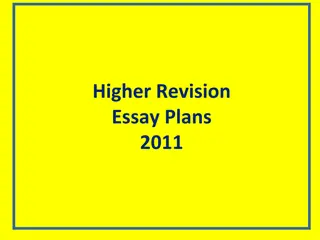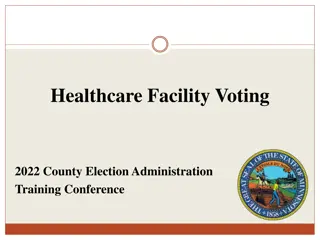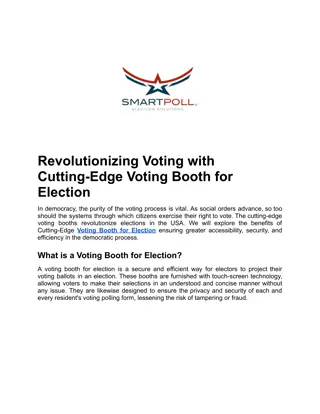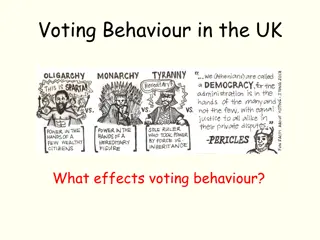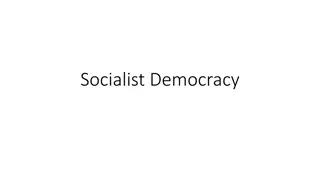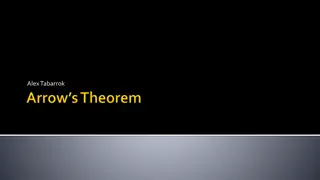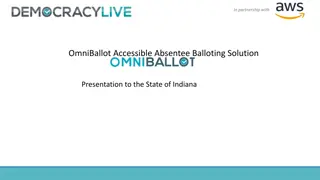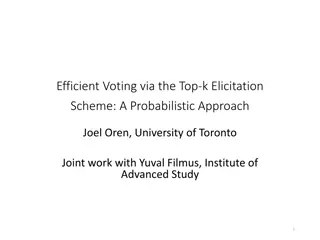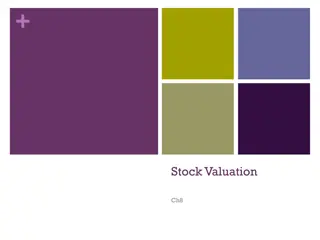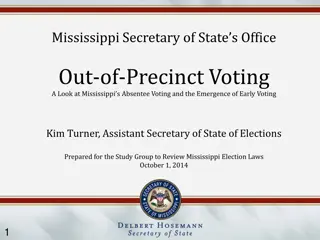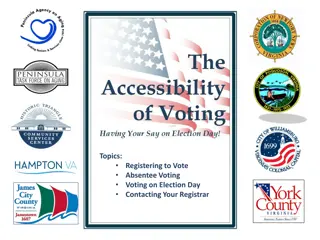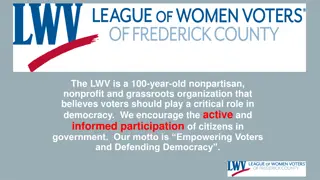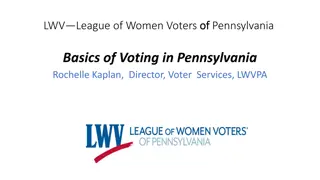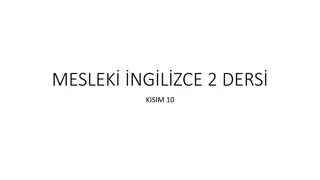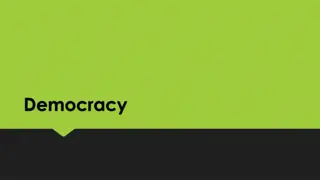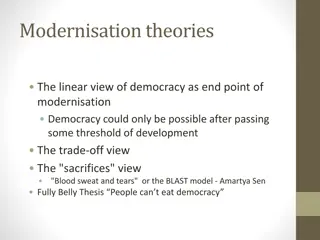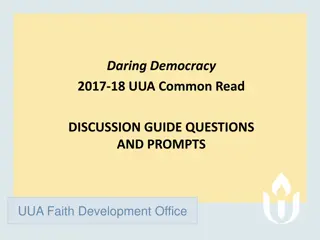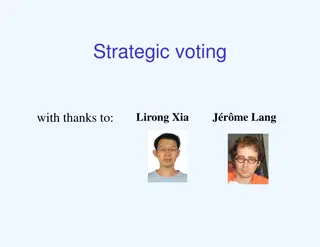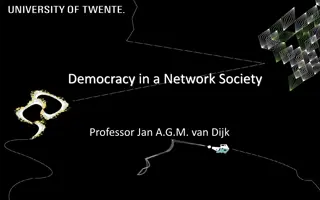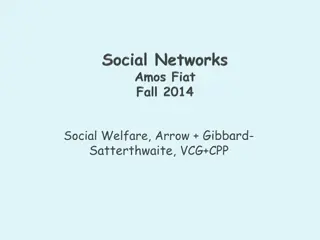Implementing Group Decision-Making Tools with Voting Procedures at Toulouse E-Democracy Summer School
Decision-making in organizations is crucial, and group decision-making can lead to conflicts due to differing views. Group Decision Support Systems (GDSS) are essential for facilitating decision-making processes. The Toulouse E-Democracy Summer School discusses the implementation of voting tools in GRUS, a Group Decision Support System developed at IRIT. Various voting procedures and existing methods are explored, emphasizing the significance of collaborative decision-making tools.
Download Presentation

Please find below an Image/Link to download the presentation.
The content on the website is provided AS IS for your information and personal use only. It may not be sold, licensed, or shared on other websites without obtaining consent from the author. Download presentation by click this link. If you encounter any issues during the download, it is possible that the publisher has removed the file from their server.
E N D
Presentation Transcript
TOULOUSE E-DEMOCRACY SUMMER SCHOOL TOULOUSE, FRANCE JUNE 27TH JULY 4TH 2017 UNIVERSIT PAUL SABATIER - IRIT Implementing Voting Tools in GRUS Adama Coulibaly1,2 1 University of Toulouse / IRIT, Toulouse, France 2 University of Bamako / USTTB-FST, Bamako, Mali Adama.Coulibaly@irit.fr Morteza Yazdani University of Toulouse, IRIT
Summary 2 INTRODUCTION AND BACKGROUND RELATED WORK Voting procedures Existing voting tools: RoboVote , Whale4 VOTING TOOLS IN GRUS CONCLUSIONS AND PERSPECTIVES REFERENCES 9/21/2024 Toulouse E-Democracy Summer School (TESS)- Universit Paul Sabatier - IRIT
INTRODUCTION AND BACKGROUND (1) 3 Decision-making is part of the fundamental goals of any organization and their management. Any organization depends on the nature of the service or product they produce they need to make decisions [1]. Making a decision is choosing from a set of alternatives to solve a problem in a given context [2]. Decision making can be done individually or by group of experts. A group decision making often creates conflict situations due to different points of views and interests of decision-makers about the same set of objects. So, a system to make decision making by group of users is required. Group Decision Support Systems (GDSS) are developed to help decision makers offering tools like a package of software for group decision[3]. Toulouse E-Democracy Summer School (TESS)- Universit Paul Sabatier - IRIT 9/21/2024
INTRODUCTION AND BACKGROUND(2) 4 The elements of a DSS can be these items: The facilitator is an actor who handle the process of group decision making: technical level, the content, consensus. The facilitator is allowed to choose the most appropriate procedure depending on the type of the working context of the group through a recommendation mechanism. Few software packages to assist the facilitator in the decision- making process. 9/21/2024 Toulouse E-Democracy Summer School (TESS)- Universit Paul Sabatier - IRIT
A decision support system 5 MBMS DBMS User Human / Computer Interface Sprague and Carlsson (1982) Definition: mix of devices, software, persons, processes, allowing collaboration among group of persons. (Sprague and Carlson, 1982) -- A Group DSS has been developed at IRIT called GRUS (GRoUp Support) [4]. We develop a tool by implementing different voting procedures. 9/21/2024 Toulouse E-Democracy Summer School (TESS)- Universit Paul Sabatier - IRIT
RELATED WORK(1) 6 Voting procedures Existing methods We can mention the methods: BLACK, NANSON, HARE, KEMENY, MAXIMIN, DODGSON, etc. The two most common methods are BORDA and Condorcet. Voting individual mode of expression allowing a group of people to make a decision. There are procedures that have emerged depending on situations. is considered as an COOMBS, COPELAND, several voting the specific 9/21/2024 Toulouse E-Democracy Summer School (TESS)- Universit Paul Sabatier - IRIT
RELATED WORK(2): Borda Method 7 If we have n candidates or alternatives this method works as follows: Each voter classifies alternatives in his/her preference order For each ranking level, points are awarded to each alternative as follows: The first-place ranking receives n points, the 2?? place ranking ? ? points, and so on. The last place ranking receives (1) point The alternatives are then ranked in the preference order by accumulated points. And the alternative that gets the highest points is the winner. 9/21/2024 Toulouse E-Democracy Summer School (TESS)- Universit Paul Sabatier - IRIT
RELATED WORK(3): Borda Method 8 P(B)= (2*3) +(3*2) +(2*1) =14 points P(C)= (2*3) + (4*2)+1=15 points So, C is the winner Example: seven (7) voters 1, 2, 3, 4, 5, 6, 7, ordering candidates, A, B, C, as follows three (3) P(A)= (3*3) +(4*1) =13 points 9/21/2024 Toulouse E-Democracy Summer School (TESS)- Universit Paul Sabatier - IRIT
RELATED WORK(4): Condorcet Method 9 If we have n candidates or alternatives, this method works as follows: Each voter classifies alternatives in his/her preference order To determine the priority of the alternatives, we compare each pair (duel) of alternatives based on voters score The winner is the one that has won all its duels against the other alternatives 9/21/2024 Toulouse E-Democracy Summer School (TESS)- Universit Paul Sabatier - IRIT
RELATED WORK(5): Condorcet Method 10 Let us use the same example and taking ">" as a representation of the preference relation of one candidate to the other C won all duels, therefore it is the winner. 9/21/2024 Toulouse E-Democracy Summer School (TESS)- Universit Paul Sabatier - IRIT
RELATED WORK(6) 11 Existing voting tools: Several tools are developed, some of them are free and other are not. Among them we can refer to Condorcet Vote [10], Decision Maker [11] [12], RoboVote [13], Tricider [14], Whale4 [15], Electionrunner [16], VoxVote [17], Doodle [18]. 9/21/2024 Toulouse E-Democracy Summer School (TESS)- Universit Paul Sabatier - IRIT
Whale4 (WHich ALtervative is Elected) It is a web application dedicated to collective decision-making and voting. One can create a poll (open or secret), invite people to participate, and view the results. Whale4 offers several modes of preference expression (ordinal, qualitative, binary, numerical), and relies on voting theory to deliver the results [15]. [Sylvain Bouveret (Ensimag, Grenoble-INP)]. It offers COPLAND and Maxmin methods. http://strokes.imag.fr/whale4/ 12 9/21/2024 Toulouse E-Democracy Summer School (TESS)- Universit Paul Sabatier - IRIT
RoboVote (Carnegie Mellon and Harvard University): is a free on-line service that helps users to combine their preferences or opinions into optimal decisions. 13 The website builds on research conducted in the multi-agent systems community, to facilitate collective decision making among autonomous software agents via computational social choice. http://robovote.org/ 9/21/2024 Toulouse E-Democracy Summer School (TESS)- Universit Paul Sabatier - IRIT
VOTING TOOLS IN GRUS(1) 14 GRUS is equipped with several collaborative tools and can be used in various decision-making situations. Facilitator can invite participants and make a meeting to decide about a subject. Depending on the contexts, GRUS allows to define the stages of the decision-making process of a group. A facilitator can choose and design a decision-making process which can be composed of the following steps: - Brainstorming - Categorization of ideas - Establishment of consensus. In the case of a consensus, it will be easy to conclude. 9/21/2024 Toulouse E-Democracy Summer School (TESS)- Universit Paul Sabatier - IRIT
VOTING TOOLS IN GRUS(2) 15 GRUS has the ability to interact in the processes of a meeting, with the other tools existing on GRUS; it follows this logical architecture DM pr f rence Methods Constraints Voting Engine Out put Alternatives Clusters Results In put 9/21/2024 Toulouse E-Democracy Summer School (TESS)- Universit Paul Sabatier - IRIT
VOTING TOOLS IN GRUS(3) 16 we have developed the Borda method for GRUS. For example: In a management meeting of a company, five experts must decide on the adoption of a new source of energy with respect to the environmental issues. The proposed alternatives are: wind, solar or hydroelectric. The following table represents the voters preferences. ?1 ?2 ?3 ?4 ?5 Ranking Wind Hydroelectric Wind Solar Solar Hydroelectric Solar Wind Solar Hydroelectric Wind Wind Solar Hydroelectric 1th 2nd 3th Hydroelectric 9/21/2024 Toulouse E-Democracy Summer School (TESS)- Universit Paul Sabatier - IRIT
With the GRUS voting tool, the facilitator must do the following: a) Create a meeting that takes into account the data of the example as shown in Figure 2; 17 Figure2: Voting creation Screen 9/21/2024 Toulouse E-Democracy Summer School (TESS)- Universit Paul Sabatier - IRIT
b) Let the participants vote: Expression of the preferences of each voter as shown in Figure3; 18 Figure3: Vote participation screen 9/21/2024 Toulouse E-Democracy Summer School (TESS)- Universit Paul Sabatier - IRIT
a) Report the result of voting (see Figure 4) 19 So the Solar with 36,7% is chosen by the management team. it contains graphical scale to show visually the score of each energy source with their percentage and relevant points. 9/21/2024 Toulouse E-Democracy Summer School (TESS)- Universit Paul Sabatier - IRIT
CONCLUSIONS AND PERSPECTIVES(2) 20 As in perspectives of this work, we propose to: implement other voting procedures in the GRUS s plugin voting tool; conduct a detailed study of the impact of meeting contexts in order to implement the recommendation feature in this voting tool; integrate the plugin into the GRUS's toolbox. We recommend developing GRUS based on the Promethee | Electre [19] Thank you 9/21/2024 Toulouse E-Democracy Summer School (TESS)- Universit Paul Sabatier - IRIT
REFERENCES 21 1. A. Abdelkader, Aide la Facilitation pour une prise de D cision Collective : Proposition d'un Mod le et d'un Outil Universit de Toulouse, 2010. P. Zarat , Outils pour la d cision coop rative, Toulouse : Herm s, 2013. G. L. Kolfschoten, M. Den Hengst-Bruggeling, G.J. De Vreede, Issues in the Design of Facilitated Collaboration Processes Group Decision and Negotiation, pp. 16, 347-361., 2007. P. Zarat , D.M. Kilgour et K. Hipel, Private or Common Criteria in a Multi-Criteria Group Decision Support System! An Experiment Collaboration and Technology: 22nd International Conference, CRIWG, 2016. S. J. Brams, D. M. Kilgour, Narrowing the field in elections: the next-two rule Journal of Theorical Politic, pp. 24,4,504-525, 2012. D. Lepelley, H. Smaoui, Choix collectif et proc dures de vote Eco Flash, pp. 1-20, 2012. D. Bouyson, T. Marchant, P. Perny, Th orie du choix social et aide multicrit re la d cision pp. 1-40, 2005. A. T. De Almeida, H. Nurmi, Aiding the choice of a voting procedure GDSS2014, 2014. S. J. Brams, P. C. Fishburn, Handbook of social choice and welfare: chap4 Voting procedure, Elsevier, 2002, pp. 175- 227. 10. J. Boudry, Condorcet Vote . Available: https://www.condorcet.vote/. [Acc s le 01/ 2017]. 11. Decision Maker de Borda Institute, [En ligne]. Available: http://www.decision-maker.org/content/voting-systems. [Acc s 01/2017]. 12. De Borda Institute, Voting system from de Borda counting . Available: http://www.deborda.org/. [Acc s 11/2016]. 13. Carnegie Mellon University, Harvard University, RoboVote . Available: http://www.robovote.org/. [Acc s 01/ 2017]. 14. N. Graf von Kanitz, S. Eyl, Tricider . Available: https://www.tricider.com/. [Acc s 01/ 2017]. 15. Whale3 . Available: http://strokes.imag.fr/whale3/. [Acc s 01/ 2017]. 16. Electionrunner . Available: https://electionrunner.com/. [Acc s 01/ 2017]. 17. V. Van Witteloostuyn, VoxVote Available: http://www.voxvote.com/. [Acc s le 01/ 2017]. 18. Doodle, Doodle - Le vote en ligne . Available: https://doodle.com/fr/vote-en-ligne. [Acc s 01/2017]. 19. R. Perez Palha, P. Zarate, and A. Teixeira de Almeida Choice of voting procedure for implementation in GDSS , GDN, 1-7, 2016 2. 3. 4. 5. 6. 7. 8. 9. 9/21/2024 Toulouse E-Democracy Summer School (TESS)- Universit Paul Sabatier - IRIT




